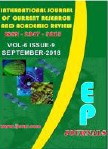Abstract Volume:6 Issue-9 Year-2018 Original Research Articles
 |
Online ISSN : 2347 - 3215 Issues : 12 per year Publisher : Excellent Publishers Email : editorijcret@gmail.com |
2Docentes Investigadores ESPOCH
The main objective of this study to obtain tuna wine (Opuntia ficus-indica) in general, in the first instance the NTE 1750 regulation was used to establish the sample size of fruit in the experimental development; with one of which, the procedures are directed to the production of wine of fruits and traditional wine; by means of the fermentation process when using types of yeast: Saccharomyces cerevisiae and Saccharomyces cerevisiae var. Bayanus. The raw material was analyzed under physicochemical parameters according to NTE 978, resulting in a defective percentage: 1.93%, ºBrix: 15%, pulp content: 54.33%, and titratable acidity (citric acid): 0.20 %, medium size and extra grade; and microbiological parameters according to NTE 2337, yielding results for molds and yeasts: 20 CFU / g and Mesophilic Aerobics: 70 CFU / g, thus accepting processing. An alcoholic strength close to 12% (v / v) and a pH: 3.5 in the final product is adjusted to 21º Brix and a titratable acidity of 0.55%. The end of the fermentative process at 20ºC is established through daily readings of ºBrix, thus the first fermentation test lasts for 8 days and the second for 10 days. The resulting fermented musts are clarified in the following dosages: 60 g / hL of bentonite, 8 g / hL of gelatin and 40 g / hL of bentonite, 8 g / hL of gelatin with an execution time of 8 days and 6 days respectively. Through a sensory analysis by the affective method, a general acceptance of 22%, 65% and 17% is obtained for the first and second tests, and the third corresponds to the control sample, is characterized by the wine with the highest acceptance according to the NTE standard. 374, obtaining: Alcohol 11.87% (v / v), Volatile acidity (acetic acid): 1.31 g / l; Total acidity (tartaric acid): 6.23 g / L; Total sulfur dioxide: 381.22 mg / L; Methanol: <2.00 mg / L and sugar content: 6.40 g / L; therefore its production is established; Based on the time of production and content of residual sugars, it is classified as a young and dry wine according to the NTE INEN 0338 standard.
How to cite this article:
Guerrero J., M. Parada, V. Tapia and Vallejo S. 2018. Production of Tuna (Opuntia ficus-indica) Wine by Alcoholic Fermentation for Industrial Processing.Int.J.Curr.Res.Aca.Rev. 6(9): 72-82doi: https://doi.org/10.20546/ijcrar.2018.609.007



Quick Navigation
- Print Article
- Full Text PDF
- How to Cite this Article
- on Google
- on Google Scholor
- Citation Alert By Google Scholar
